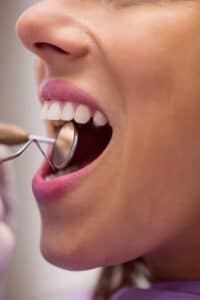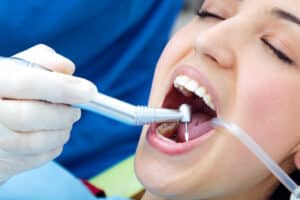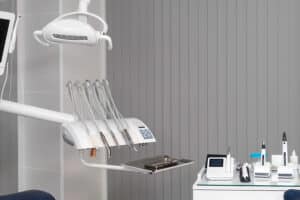When was the last time you had your teeth professionally cleaned by a dentist or dental hygienist? Regular teeth cleaning is a crucial part of maintaining good oral health. It not only keeps your teeth looking their best but also helps prevent various dental issues.
But have you ever wondered about the tools and instruments that dental professionals use to clean your teeth effectively? Understanding these tools can help demystify your dental visits and make you more informed about your oral care.
Basic Tools for Teeth Cleaning
Dental Mirror

The dental mirror is a small, handheld tool with a mirror at one end. Dentists use it to get a better view of all the surfaces of your teeth, including those hard-to-reach areas. By reflecting light into your mouth, the mirror helps them spot hidden dental issues.
Types of Mirrors
There are different types of dental mirrors, each designed for specific purposes. Front-surface mirrors, for example, provide a clear image without any distortion, while magnifying mirrors help in detailed examinations.
Teeth Cleaning Scalers
Scalers are among the most commonly used dental instruments. They come in various shapes and sizes, but all share the same purpose: removing plaque and tartar buildup from your teeth. Plaque is a sticky film of bacteria that can lead to cavities and gum disease if left untreated. Tartar is a hardened plaque that can only be removed with specialized tools.
Types of Scalers
Dental scalers can be categorized into curettes and scalers. Curettes are designed for deep cleaning below the gumline, while scalers are used to remove plaque and tartar from the tooth’s surface. Dental professionals choose the appropriate scaler based on the specific cleaning needs of each patient.
Advanced Tools and Equipment
While dental mirrors and scalers are essential for teeth cleaning, modern dentistry has seen the development of more advanced tools and equipment to enhance the cleaning process and provide a higher level of care. Let’s explore these advanced instruments:
Ultrasonic Scalers
Ultrasonic scalers are becoming increasingly popular in dental practices due to their effectiveness and efficiency. These devices use high-frequency vibrations to remove plaque and tartar. Some of their key benefits include:
- Faster and more thorough cleaning.
- Reduced discomfort during the cleaning process.
- Less need for manual scraping, which can be gentler on teeth and gums.
How They Work: Ultrasonic scalers have a small, vibrating metal tip that vibrates at ultrasonic frequencies. When the tip touches the tooth’s surface, it breaks down and removes plaque and tartar through a process called cavitation. The scaler also sprays water to cool and flush away the debris.
Air Polishers
Air polishers are another advanced tool used in teeth cleaning. They are particularly effective in removing surface stains caused by coffee, tea, smoking, and other sources. Here’s how they work:
- Air polishers use a mixture of air, water, and a specially formulated polishing powder.
- The high-velocity spray of this mixture effectively removes stains and dental plaque from the tooth’s surface.
- It leaves your teeth feeling smoother and looking cleaner.
Advantages of Air Polishing
Patients often appreciate air polishers for several reasons:
- They are gentle on the tooth’s enamel, reducing the risk of damage.
- The procedure is typically quick and comfortable.
- The removal of stains can significantly improve the aesthetics of your smile.
Dental X-rays
Dental X-rays are a useful diagnostic tool that dentists use to evaluate the health of your teeth and the underlying structures that aren’t visible to the naked eye. They are especially crucial for:
- Detecting cavities between teeth.
- Evaluating the health of tooth roots.
- Checking for bone loss or abnormalities.
- Identifying impacted teeth or other oral issues.
Types of Dental X-rays: There are different types of dental X-rays, including bitewing, periapical, and panoramic X-rays. Each type serves a specific purpose, allowing dentists to get a comprehensive view of your oral health.
Emerging Trends in Teeth Cleaning Tools
The field of dentistry is continually evolving, and new technologies and techniques are being introduced to enhance dental cleaning. These advancements include:
- Laser Dentistry: Laser technology is gaining prominence in teeth cleaning procedures. These precise tools emit focused beams of light to remove plaque, tartar, and damaged tissue. Laser dentistry offers several advantages, including reduced discomfort during treatments and faster healing times.
- 3D Imaging: The use of 3D imaging technology is revolutionizing the way dentists diagnose and plan treatments. It provides a detailed, three-dimensional view of a patient’s oral structures, allowing for more accurate assessments and customized treatment plans. This technology enhances both the diagnostic process and treatment outcomes.
How Technology Is Changing Teeth Cleaning
- Digital Records: Dentistry is transitioning from traditional paper records to digital systems. Digital records enable dental professionals to efficiently access and manage patient information, treatment history, and X-rays. This streamlined approach enhances communication among healthcare providers and ensures that patients receive comprehensive care.
- Teledentistry: Teledentistry leverages telecommunication technology to enable remote consultations and follow-ups with dental professionals. Patients can seek advice, discuss concerns, and receive guidance from the comfort of their homes. This innovation enhances accessibility to dental care, particularly for individuals in remote or underserved areas.
These emerging trends are significantly influencing the landscape of teeth cleaning, making it more efficient, precise, and patient-friendly.
Sterilization and Infection Control
Aside from the tools used, maintaining a clean and sterile environment in dental practices is of utmost importance to protect both patients and dental professionals from the risk of infection. The sterilization and infection control include:
- Instrument Cleaning: Dental instruments are thoroughly cleaned to remove debris and contaminants before sterilization. This step is crucial to ensuring the effectiveness of the sterilization process.
- Autoclaves: Autoclaves are commonly used to sterilize dental instruments. These machines use steam under pressure to kill microorganisms. Explain how autoclaves work and their role in maintaining a sterile environment.
- Disposable Items: Mention that some items, like gloves and syringe needles, are disposable and used only once to eliminate the risk of cross-contamination.
- Personal Protective Equipment (PPE): Dental professionals wear PPE such as masks, gloves, and gowns to protect themselves and patients. Discuss the importance of proper PPE usage.
- Surface Disinfection: Dental chairs and surfaces are regularly disinfected to prevent the spread of germs. Highlight the attention to detail in maintaining a clean environment.
- Regulatory Compliance: Mention that dental practices must adhere to strict regulations and guidelines set by health authorities to ensure the highest standards of sterilization and infection control.
Ready to Transform Your Smile?
Discover the exceptional dental care you and your family deserve at Advanced Emerald Dentistry, proudly serving Puyallup and Graham, WA. We offer gentle and caring procedures without compromising on quality!
Your family’s oral health is in the hands of our highly trained and experienced team, including Dr. Parvin Abedi, Dr. Jenny Fang, and Dr. Sobhani. We can take care of all of your dental needs, from regular checkups and cleanings to emergency care and cosmetic work.
Don’t wait—prioritize your oral health today!


